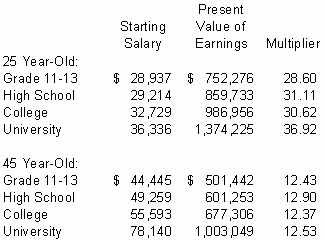by Scott Beesley
This article was originally published in the spring 1999 issue of the Expert Witness.
Note that this article is the second of a two-part article. You will find part 1 here
Methodology of the Calculation
Damages in fatal accident actions are calculated in two steps. First the lump-sum value of the deceased’s income after taxes and after deduction of personal expenses is determined. Then, to this is added a tax “gross up,” to account for the tax liability the survivors will incur when the settlement earns interest.
Injury claims, on the other hand, are calculated using before-tax income, but no gross-up is added. The law implies that the fraction of the injured party’s income which would have gone to tax will now roughly equal the tax liability incurred because of interest on the lump sum awarded (through all future years). This equivalence is only roughly correct, though, and it would in fact be more accurate to calculate injury claims in the same manner as fatalities.* One reason that this is not done is that the tax rate any one person would have paid would have depended on their choices in life, including the presence or absence of children, the amount they would have saved or donated, and even the occupation chosen itself (some allow income to be shielded from tax more easily). The injury protocol finesses this uncertainty by working in pre-tax income.
In the case of Survival of Actions (SAA) cases, there may be an alternative method of dealing with this uncertainty. First, recognise that, as income increases, the percentage of income required for “expenses incurred in the course of earning income” is likely to decrease. That is, the necessities component of the deduction (by which I now mean expenses other than tax) declines as a percentage with increasing income. Second, at the same time, the percentage of income devoted to income tax will definitely increase. The two components of the deduction are therefore moving in different directions as income is increased: The tax percentage increases while the percentage cost of other necessities decreases. The overall total could be relatively constant with respect to income, depending of course on what sort of dependence is assumed for the necessities cost as a function of income. In most cases the total deduction (and therefore the award) may not vary far from 50 percent of gross income.
If the courts wished to simplify loss calculations somewhat, the above argument would justify calculating damages under the SAA in the same manner as in injury cases (i.e. using before-tax income), but with a deduction on the order of 50 percent. Note that this would exactly split the difference between the former common law result, which would have awarded nothing in the absence of dependents, and the awarding of 100 percent of before-tax income that would occur in the case of a surviving but completely unemployable plaintiff. One could then say that the pro-deterrence and anti-windfall gains positions had been given approximately equal weight. The error of such a simplification is that the calculation would not account for differences in tax rates across the income scale, nor would it correctly deduct necessities, if it was determined that the true cost of necessities is a flat dollar figure, not some percentage of income. As discussed in the previous paragraph, across the broad centre of the income distribution, the error is actually quite small. At very low incomes, a flat deduction would overstate tax and understate necessities, while the reverse occurs at high incomes.
To Gross-up or not to Gross-up?
We note that in an opinion recently provided to Economica regarding a case in progress, former Justice Kerans stated that he felt that a gross-up continued to be appropriate as part of the process of capitalising the award, assuming the goal is to replicate the year-by-year loss. If it is eventually decided that the Survival of Actions Act should require that in each future year, the estate should receive (for example) 50 percent of pre-accident after-tax income, then a gross-up is necessary. If, on the other hand, it is decided that only a one-time lump payment is needed, then the gross-up should be omitted.
Some may object to the idea that the size of the final award should depend on the financial status of the recipients of the award, yet that is already the case in the current fatal accidents methodology. A surviving spouse whose income is higher receives a higher award because of a larger gross-up, even if all other case facts are identical.
Finally, we note that in the recent further Duncan decision, no gross-up was applied. Please refer to page 8 for details regarding this decision.
Simultaneous Fatal Accidents Act and Survival of Actions Act Claims
The Rationale and the Calculation
It may be possible to make a joint claim under the Survival of Actions Act (SAA), and the Fatal Accidents Act (FAA), to the extent that some part of a deceased person’s income is claimable under the SAA and not already claimed under the FAA. We provide an example of how such a claim might be estimated. First, assume that the dependency is the usual spousal figure of 70 percent, which, though not mandated in any way, appears to have been accepted as reasonable in most cases. That dependency consists of 40 percent (of the deceased’s after-tax income) for common expenses, and 30 percent for expenses that benefit the survivor alone. The 30 percent which is deducted from the FAA award represents the amount which would have benefited the deceased alone, and hence is not relevant for the FAA calculation. We assume a necessities deduction of 33 percent, with 15 percent contained in the 30 percent FAA deduction, and 18 percent within the 40 percent allotted for common expenditures. With these assumptions, half of the 30 percent deducted under the Fatal Accidents Act cannot be claimed under the Survival of Actions Act, since it covers necessities and is to be deducted. The remaining 15 percent, however, is claimable under the Survival of Actions Act, and has not already been claimed under the FAA, since it did not go to support dependents. (Of course, this entire interpretation is only possible if the courts eventually settle upon a lost years deduction which reflects some measure of necessities, and further clarify how that deduction overlaps with the division of after-tax income under the Fatal Accidents Act.)
Table 1 below will, hopefully, clarify the above example.
Table 1: Combined Claims under the Fatal Accidents Act and the Survival of Actions Act
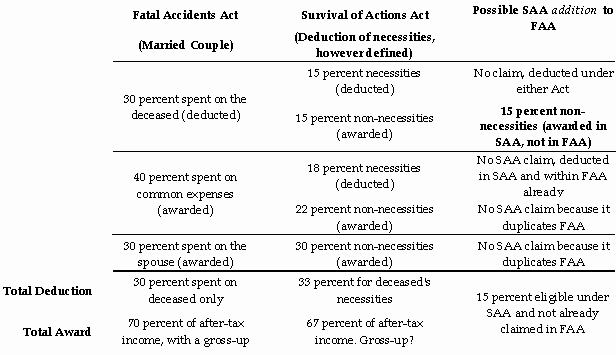
Divorce and Remarriage
Fatal Accidents Act calculations are commonly reduced by the use of contingencies for divorce and remarriage. A pre-accident divorce would obviously have ended a spousal dependency relationship (subject perhaps to a loss of support claim), while a post-accident remarriage may be presumed at times to reduce or eliminate the dependency by replacing the deceased’s income with that of a new spouse. Claims under the Survival of Actions Act are not subject to these reductions, it would appear, since the law allows claims by the estate, not FAA dependents. Of course, the beneficiaries of the estate and the dependents will often be one and the same. If SAA claims are interpreted as not subject to divorce and remarriage, then a large fraction of any amount deducted from an FAA claim because of those contingencies is simply added to the SAA claim. We note that not all of the deduction is added back, because the necessities component of common income (the 18 percent in Table 1) cannot be claimed under the Survival of Actions Act.
Continuing with the Table 1 example, assume that the 70 percent dependency claim had been reduced by 40 percent as a result of the divorce and remarriage contingencies. The reduction as a percentage of after-tax income is 28 percent (40 percent of 70 percent). Of that reduction, a fraction equal to 52/70 can be reclaimed under the SAA, since all but 18 of the 70 percent is claimable using that Act. Table 2 below provides an example of the calculation, presuming that after-tax income has a present value of $1,000,000. It continues the assumptions on Table 1 regarding dependency and the division of necessities across common and personal expenses (18 and 15 percent, respectively). Note that in addition to the divorce and remarriage reclamation under the SAA, we also include the 15 percent claim for the deceased’s personal non-necessities, as discussed in detail above.
Table 2: Reclaiming of Divorce and Remarriage Reductions Under the Survival of Actions Act
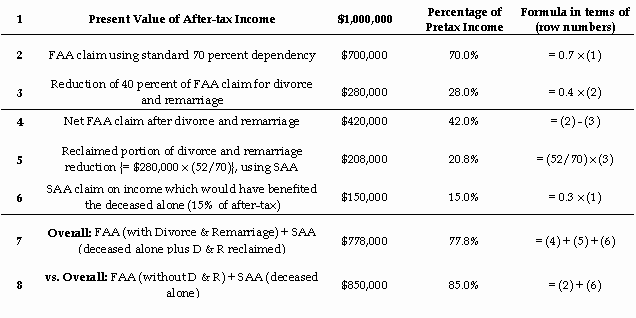
Comments on the recent Brooks v. Stefura decision
In Brooks v. Stefura, Justice Belzil interpreted Duncan as suggesting that almost everything the deceased would have spent should be deducted from an estate award. He deducted: future spending by the deceased on vehicles and other discretionary items, the deceased’s own expenses on essentials, and also all the expenses the deceased would have incurred for a hypothetical second spouse and family. We would first note that this deduction of a large majority of spending is roughly equivalent to awarding savings only, an approach that was explicitly rejected by Justice Kerans. It is also difficult to understand how spending on, for example, motorcycles and electronic equipment could be said to constitute an obligation, in the sense of spending on family support. Surely such optional expenditures should be considered discretionary. The fact that they might have been debt financed is irrelevant, except that one might argue that the interest should perhaps be considered an obligation. After summing all these components, Justice Belzil arrives at an 80 percent deduction. As it is, this is roughly a savings-only award, with an effective deduction from before-tax income of roughly 85 percent.
A further issue is that, in fact, Brooks uses a lost years deduction larger than the stated 80 percent, without acknowledging as much. With all due respect, we note that there appears to be a logical inconsistency in Brooks. Having listed all the “obligations” of the deceased, and having made clear that he believes that 80 percent of spending would have gone to such items, Justice Belzil then takes the Fatal Accidents Act claim from the remaining 20 percent of after-tax income. Yet this implies that the true lost years deduction being applied here is over 95 percent of after-tax income, or 97 percent of before-tax income. This level of deduction is far beyond the 33 to 53 percent range seen in the previous cases in all jurisdictions. It would seem quite clear that spending on the deceased’s first wife and his children, as estimated under the Fatal Accidents Act, would be an “obligation” under Justice Belzil’s rationale. Justice Belzil in fact writes exactly that at paragraph 249. In that case the FAA award should be considered to be an additional component of the true lost years deduction, and Justice Belzil would then report having used a lost years deduction of roughly 95 percent of after-tax income, or even more as a percentage of before-tax income.
I would suggest that the actual deduction used should be reported correctly, inclusive of any FAA award, which is clearly all deducted under Justice Belzil’s methodology. The overall award would have more accurately been reported as the roughly 2 to 3 percent remaining under the Survival of Actions Act, plus the Fatal Accidents Act award. Alternatively, the plaintiff could have been awarded the FAA amount, from dollars which are within the 80 percent deduction, and also received the 20 percent granted under the SAA. The figures involved are shown in Table 3 below.
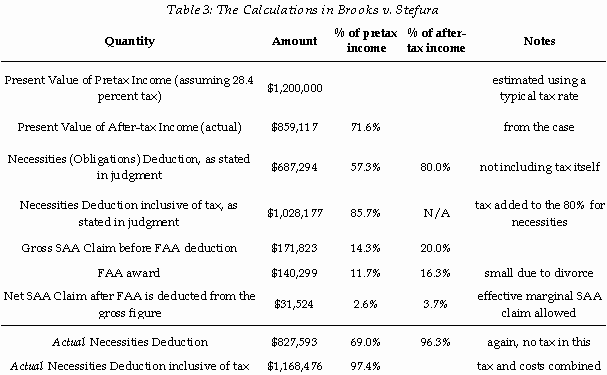
If the Fatal Accident Act amount had been assumed to come from within the 80 percent SAA deduction, the total award would have been approximately $312,122, or the sum of $140,299 (FAA) and $171,823 (SAA).
It is difficult to understand why the FAA amount was deducted from the 20 percent which is deemed discretionary, without granting that what is really being done is presuming obligations of over 95 percent of after-tax income, or almost 100 percent of before-tax income. Finally, I note that the true lost years deduction in Brooks is actually well in excess of what would be used in a correctly estimated “savings-only” calculation, and that was rejected in Duncan as not generous enough.
A New Decision in Duncan v. Baddeley
On February 2, 1999 a decision was released in the Duncan v. Baddeley case. The Court of Appeal decision had returned the case to the lower court for calculation of the estate’s loss, using principles laid out in the judgment of Mr. Justice Kerans. Madam Justice Sulyma considered how to interpret the Court of Appeal’s judgment, and concluded that a moderate “lost years” deduction, equal to 35 percent of after-tax income, was appropriate. That was in addition to the deduction of tax itself, calculated to be 28 percent of before-tax income. The overall deduction from before-tax income is 53.2 percent. Two further contingency reductions of 5 percent each were also applied. The award was calculated as shown on Table 4 below. (No mention was made of a gross-up, so presumably such was not awarded.)
Madam Justice Sulyma rejected the suggestion that only savings should be awarded, clearly stating that some reasonable estimate of “personal living expenses,” for the deceased only, was what should be deducted from after-tax income. The Justice also confirmed what seems quite clear from a reading of Justice Kerans’ decision: that the estimated overall deduction, which he felt would be 50 to 70 percent of pretax income, includes personal expenses and tax. Justice Kerans slightly overestimated income tax, and when his figures are lowered to account for that, the implied range for the overall deduction is approximately 40 to 60 percent. Justice Sulyma’s estimated deduction of 53.2 percent is therefore right in the centre of the range suggested by the Court of Appeal.
We note that the size (in percentage terms) of the personal living expenses deduction by Justice Sulyma is consistent with many previous related cases. At the given level of income, it should also be noted that the personal expenses deduction is $8,820 (= $35,000 x 0.72 x 0.35). This is very similar to the necessities deduction which would be applied if an absolute dollar figure was chosen, based on estimates of the necessities of life. We have argued in the past that such a figure should be used, if it was found that a strict definition of necessities was all that should be deducted. (One implication was that a flat amount, not a percentage, would be the appropriate deduction.)
Finally, we note that the following issue appears in many injury and fatal cases, and seems to be misunderstood at times. One of the rationales for the second 5 percent deduction applied by Justice Sulyma is that “there should be a discount for the chance that the victim would not receive the optimal award calculated by the Plaintiff’s actuary.” If we are interpreting this correctly, it seems to mean the chance that the plaintiff would not have earned as much as was assumed in the calculation. But the proper method would then be to lower the income estimate itself, not impose an arbitrary reduction. If the figure of $35,000 per annum was agreed on as the most reasonable estimate of Mr. Duncan’s annual income for full-time work, that figure itself is already net of the chances that he might have made more or less – the only additional adjustments required are for fringe benefits, disability and the risk of unemployment. More commonly, in our work we often estimate pre-accident income using the level of education a young plaintiff was likely to reach. The income path we then use is an average across many thousands of individuals, and obviously some of those individuals earn more than that average and others less. Unless there is some good reason to deliberately use an income path above or below the average, only the three adjustments above should be used (though in some cases part-time and non-participation contingencies may also apply).
Table 4: The Calculation in Duncan v. Baddeley
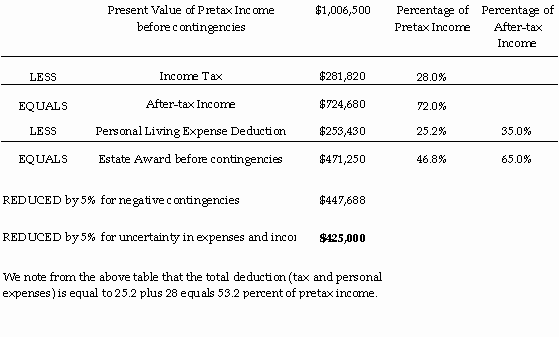
* The tax paid on this interest income could be more or less than the tax which would be payable on the annual withdrawal if it had been earned as income. In legal theory, these two deductions are similar in size over time. That is, the courts have assumed that tax on post-accident interest income lowers overall funds available to the plaintiff approximately as much as tax on pre-accident earned income would have, and the plaintiff’s after-tax loss of income has (presumably) been replaced. In practice, we find that it is more often the case that the tax on interest income has a more serious effect on funds available than pre-accident income tax would have had. [back to text of article]

Scott Beesley is a consultant with Economica and has a Master of Arts degree (in economics) from the University of British Columbia.
